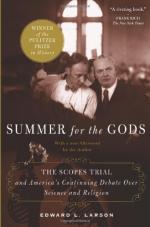
|
| Name: _________________________ | Period: ___________________ |
This test consists of 5 multiple choice questions, 5 short answer questions, and 10 short essay questions.
Multiple Choice Questions
1. As desire for academic freedom spreads to high schools, the ACLU defends teachers and what else?
(a) Makes appeals to state supreme courts.
(b) Organizes local civil protests.
(c) Publishes statements on the issue.
(d) Makes appeals to school boards.
2. In addition to Florida, which state passes a minor resolution on the anti-evolution issue in 1923?
(a) Georgia.
(b) Kentucky.
(c) South Carolina.
(d) Oklahoma.
3. Scopes is the ideal defendant in many ways being young, single, shy, well-liked, and what else?
(a) Willing to pursue postgraduate studies in law.
(b) Can offer soapbox replies about evolution.
(c) Having little to lose.
(d) Plans to publish book about the trial.
4. Why does Darrow volunteer to defend Scopes beyond believing teachers should be able to instruct evolution?
(a) Feels concern for Scopes.
(b) Seeks freedom of public education.
(c) Wants to debate Bryan.
(d) Needs national publicity.
5. Bryan offers his services to the prosecution in mid-May despite not having been practicing law for how long?
(a) Over 30 years.
(b) Over 25 years.
(c) Over 20 years.
(d) Over 15 years.
Short Answer Questions
1. Dayton, between Knoxville and Chattanooga in the Tennessee River valley, is in what part of Tennessee?
2. Another ACLU worry, if both Darrow and Bryan work on the trial, is that it would become a clash between what?
3. Talk of evolution and new fossil finds have anti-evolutionists responding how beyond calling for teaching limits?
4. Darrow grows to see evolutionary theory as a way of doing what?
5. Despite its rise, the anti-evolution movement lacks a clear, specific legal or political issue until when?
Short Essay Questions
1. How is it that this case does not seem normal from the start?
2. What key individuals come aboard the day after George W. Rappleyea?
3. What is the position that Bryan comes to aid in prosecuting?
4. William Jennings Bryan is one of the key players in this historical work. His role is what?
5. What does federalism grow out of?
6. In what fashion does defense attorney Darrow question Bryan?
7. When the Tennessee law against teaching evolution is enacted, what does the ACLU do?
8. What are two legal battles that helped make Darrow prominent?
9. What takes place as word of the Piltdown skull leaks into popular society?
10. What is the find that paleontologist Arthur Smith Woodward labels Eoanthropus dasoni?
|
This section contains 1,135 words (approx. 4 pages at 300 words per page) |

|




